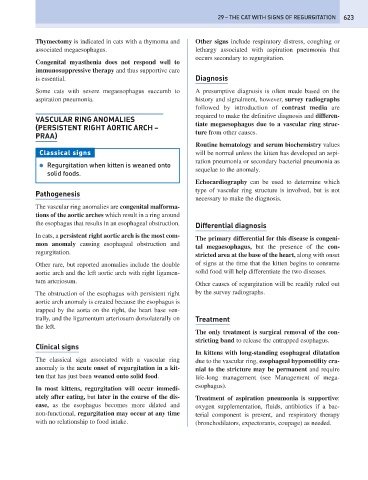Page 631 - Problem-Based Feline Medicine
P. 631
29 – THE CAT WITH SIGNS OF REGURGITATION 623
Thymectomy is indicated in cats with a thymoma and Other signs include respiratory distress, coughing or
associated megaesophagus. lethargy associated with aspiration pneumonia that
occurs secondary to regurgitation.
Congenital myasthenia does not respond well to
immunosuppressive therapy and thus supportive care
is essential. Diagnosis
Some cats with severe megaesophagus succumb to A presumptive diagnosis is often made based on the
aspiration pneumonia. history and signalment, however, survey radiographs
followed by introduction of contrast media are
required to make the definitive diagnosis and differen-
VASCULAR RING ANOMALIES
(PERSISTENT RIGHT AORTIC ARCH – tiate megaesophagus due to a vascular ring struc-
PRAA) ture from other causes.
Routine hematology and serum biochemistry values
Classical signs will be normal unless the kitten has developed an aspi-
ration pneumonia or secondary bacterial pneumonia as
● Regurgitation when kitten is weaned onto
sequelae to the anomaly.
solid foods.
Echocardiography can be used to determine which
type of vascular ring structure is involved, but is not
Pathogenesis
necessary to make the diagnosis.
The vascular ring anomalies are congenital malforma-
tions of the aortic arches which result in a ring around
the esophagus that results in an esophageal obstruction. Differential diagnosis
In cats, a persistent right aortic arch is the most com-
The primary differential for this disease is congeni-
mon anomaly causing esophageal obstruction and
tal megaesophagus, but the presence of the con-
regurgitation.
stricted area at the base of the heart, along with onset
Other rare, but reported anomalies include the double of signs at the time that the kitten begins to consume
aortic arch and the left aortic arch with right ligamen- solid food will help differentiate the two diseases.
tum arteriosum.
Other causes of regurgitation will be readily ruled out
The obstruction of the esophagus with persistent right by the survey radiographs.
aortic arch anomaly is created because the esophagus is
trapped by the aorta on the right, the heart base ven-
trally, and the ligamentum arteriosum dorsolaterally on Treatment
the left.
The only treatment is surgical removal of the con-
stricting band to release the entrapped esophagus.
Clinical signs
In kittens with long-standing esophageal dilatation
The classical sign associated with a vascular ring due to the vascular ring, esophageal hypomotility cra-
anomaly is the acute onset of regurgitation in a kit- nial to the stricture may be permanent and require
ten that has just been weaned onto solid food. life-long management (see Management of mega-
esophagus).
In most kittens, regurgitation will occur immedi-
ately after eating, but later in the course of the dis- Treatment of aspiration pneumonia is supportive:
ease, as the esophagus becomes more dilated and oxygen supplementation, fluids, antibiotics if a bac-
non-functional, regurgitation may occur at any time terial component is present, and respiratory therapy
with no relationship to food intake. (bronchodilators, expectorants, coupage) as needed.

